Key Takeaways
- Significant Financial Impact: Manual data entry costs businesses an average of $28,500 per employee annually, highlighting an urgent need for automation.
- Widespread Burnout: Over half (56%) of employees experience burnout from repetitive data tasks, leading to reduced productivity and higher turnover risks.
- High Operational Risks: Manual entry contributes to errors and delays for 50.4% of respondents, creating potential compliance issues and financial losses.
- Automation Adoption Gap: Nearly half (46.2%) of businesses have not adopted automation tools due to a lack of awareness and internal advocacy, representing untapped efficiency potential.
- Proven Automation Benefits: Among companies using automation, 96.5% report significant workload reduction, underscoring high effectiveness and user satisfaction.
- Employee Preferences: Employees overwhelmingly prefer to allocate time saved from automation towards strategic planning, customer experience enhancement, and revenue-focused tasks.
- Future Imperative: By 2030, automation of manual data entry is expected to be industry-standard. Early adopters gain competitive and strategic advantages.
In July 2025, Parseur partnered with QuestionPro to survey 500 U.S.-based professionals working in operations, finance, administration, IT, customer support, and other fields. Respondents ranged from 18 to 65 and older, with the majority between ages 26 and 45. Participants included a mix of full-time employees and contractors, with responses evenly distributed across genders.
Beyond The Numbers
Every year, manual data entry quietly drains significant resources from U.S. businesses, resources that could be redirected toward innovation, growth, and customer satisfaction. According to a detailed 2025 survey conducted by Parseur in partnership with QuestionPro, manual data entry tasks cost American companies an average of $28,500 per employee annually. But these financial costs are only the tip of the iceberg.
Why Parseur Conducted This Survey?
At Parseur, a global leader in intelligent document processing automation, we regularly witness firsthand the hidden costs and inefficiencies businesses face due to manual workflows. We commissioned this survey to gather authoritative, detailed data and provide valuable insights to business leaders, decision-makers, and industry experts. Our goal is to deepen industry understanding and catalyze conversations around automation adoption, operational excellence, and strategic innovation.
These are hours that companies are burning on tasks that can and should be automated,” said Sylvestre Dupont, co-founder of Parseur, an intelligent document processing platform. It’s not just a financial issue; it’s also about opportunity cost. The survey reveals that American workers would rather spend their time improving operations, serving customers, or working on growth initiatives. And with regulations like GDPR, extracting and using data also requires precision and auditability to avoid unnecessary legal or reputational risk.
The Hidden Price Tag Of Manual Data Entry
Employees report spending more than nine hours weekly transferring data from various formats (emails, PDFs, spreadsheets) into digital systems. Notably, employees in high-paying sectors such as IT and finance, earning between $50 and $90 per hour, amplify this financial impact, marking a crucial area for substantial operational savings.
Significant time spent on manual data entry
Respondents reported spending an average of more than 9 hours per week transferring data from emails, PDFs, spreadsheets, and scanned documents into digital systems. This aligns with the distribution of time spent:
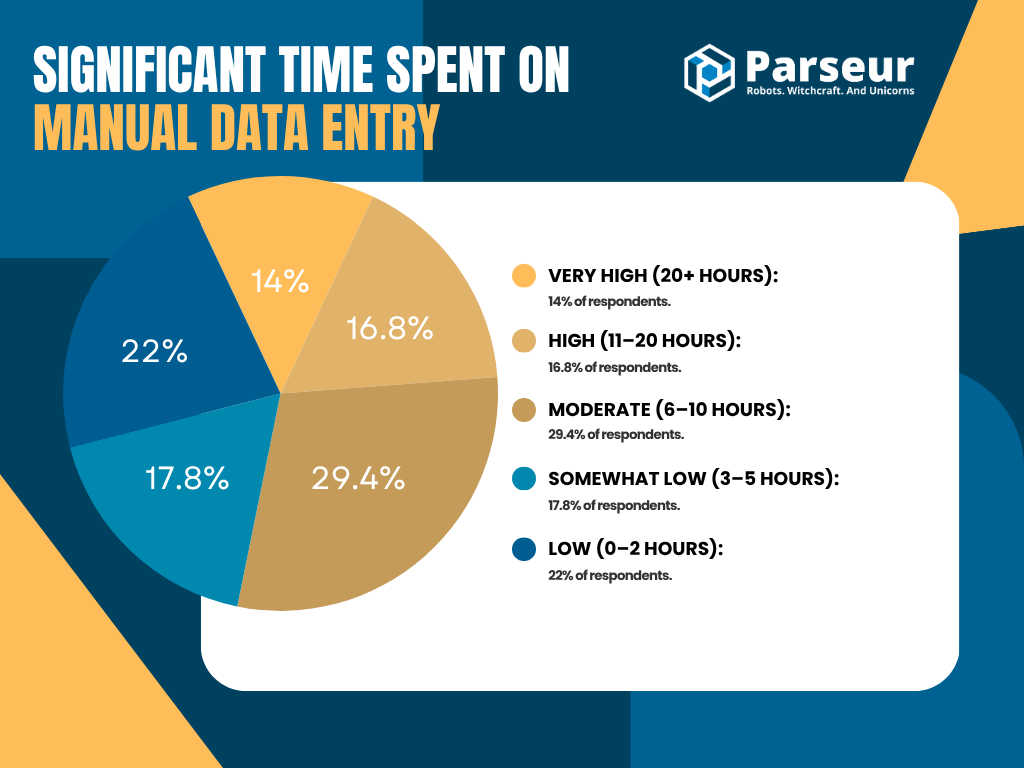
Employees in IT (12.8% of respondents) and finance (8.4%) are more likely to report very high data entry hours (20+ hours), contributing to higher costs due to their higher pay brackets ($41–$80/hour or more).
The Documents Driving The Problem
The heart of the manual data entry challenge lies in the repetitive processing of everyday business documents. According to our survey findings, several document types consistently top the list of productivity-draining tasks:
- Work Orders (34.4%): Widely used in industries like manufacturing, construction, and facility management, work orders often require repetitive data inputs. Automating these significantly reduces delays, improves accuracy, and enhances operational responsiveness.
- Purchase Orders (32%): Critical in procurement and supply chain management, manually processing purchase orders is highly error-prone and costly, making them ideal candidates for automation tools like Parseur’s intelligent document processing platform.
- Sales Orders (30%): Sales teams frequently manage numerous orders daily. Automating the extraction of customer details, product specifics, and pricing information can dramatically improve turnaround times and free sales professionals for customer-facing activities.
- Invoices (28.2%): A cornerstone of financial operations, invoice processing is notoriously tedious and prone to human error. Automating invoices reduces financial errors, accelerates payment cycles, and ensures compliance.
Beyond these common documents, the survey also revealed that manual data entry is prevalent in niche or specialized documents, including:
- Timesheets (27%)
- Bank/Credit Card Statements (25.6%)
- Customer Intake Forms (24.6%)
- Contracts and Agreements (24%)
- Shipping Receipts (23.6%)
- Resumes (18.4%)
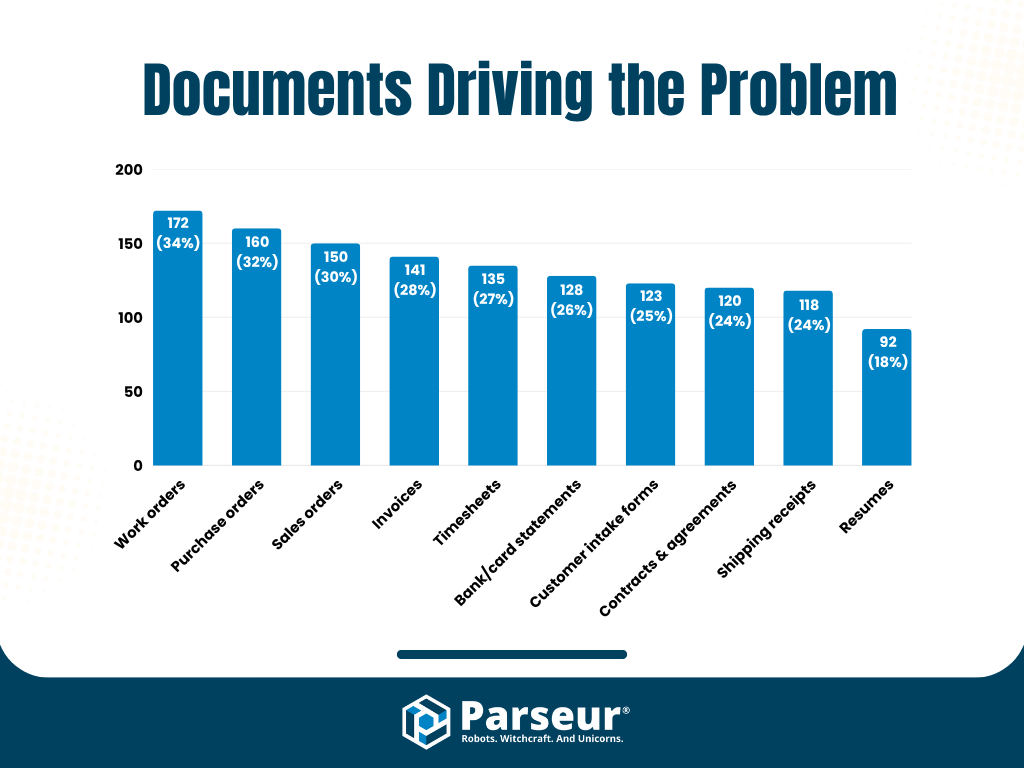
Moreover, unique documents such as educational grades, patient medical records, prescriptions, and inventory reports frequently surfaced in respondent feedback. These findings highlight how manual data entry also significantly impacts sectors such as education and healthcare, industries particularly sensitive to data accuracy, regulatory compliance, and efficiency.
Automating these repetitive document types isn't merely about saving time; it's about strategically enhancing accuracy, compliance, productivity, and ultimately enabling employees across sectors to shift their focus from mundane tasks to high-value, strategic work.
Burnout & Morale: More Than Just Frustration
Our survey found that 56% of employees experience burnout due to repetitive tasks. Psychological studies and organizational research consistently link burnout to decreased productivity, higher turnover, and lower overall morale.
Operational Risk: Costly Mistakes And Compliance Issues
Over half (50.4%) of surveyed professionals admitted that manual data entry leads to costly errors, delays, or lost opportunities. Errors aren't merely inconvenient; they carry significant compliance risks, potential financial penalties, and reputational damage, especially in sectors regulated by stringent laws like GDPR.
Bridging The Automation Gap
Despite the clear and measurable inefficiencies associated with manual data entry, our survey revealed a striking gap in automation adoption. Nearly half (46.2%) of respondents have never used any automation tools, indicating a considerable untapped potential for productivity and efficiency improvements.
One significant barrier is the lack of awareness, with 24.3% of employees reporting they simply don't know what automation solutions are available. Here, Parseur’s user-friendly, non-technical document processing platform offers an accessible entry point, providing companies and employees alike with a straightforward pathway to adopting powerful automation technology without technical barriers.
Another critical issue is the perceived lack of authority, with 27.2% of respondents feeling that deciding to implement automation isn't within their role. For these employees, Parseur recommends advocating internally by:
- Presenting automation ROI using real-world statistics and case studies.
- Demonstrating tangible examples of time and cost savings from similar businesses.
- Using internal pitches or ready-to-use presentations and demos provided by Parseur to make the case compelling and clear to management.
By empowering employees with practical advocacy tools and increasing awareness of accessible automation solutions like Parseur, businesses can effectively bridge this automation gap, turning inefficiency into a strategic advantage.
Limited adoption of automation tools
46.2% of respondents have never used tools to automate data entry or extraction, and 8.2% are unsure if they have. This indicates a significant gap in automation adoption, with nearly half of the workforce unaware of or not utilizing available solutions.
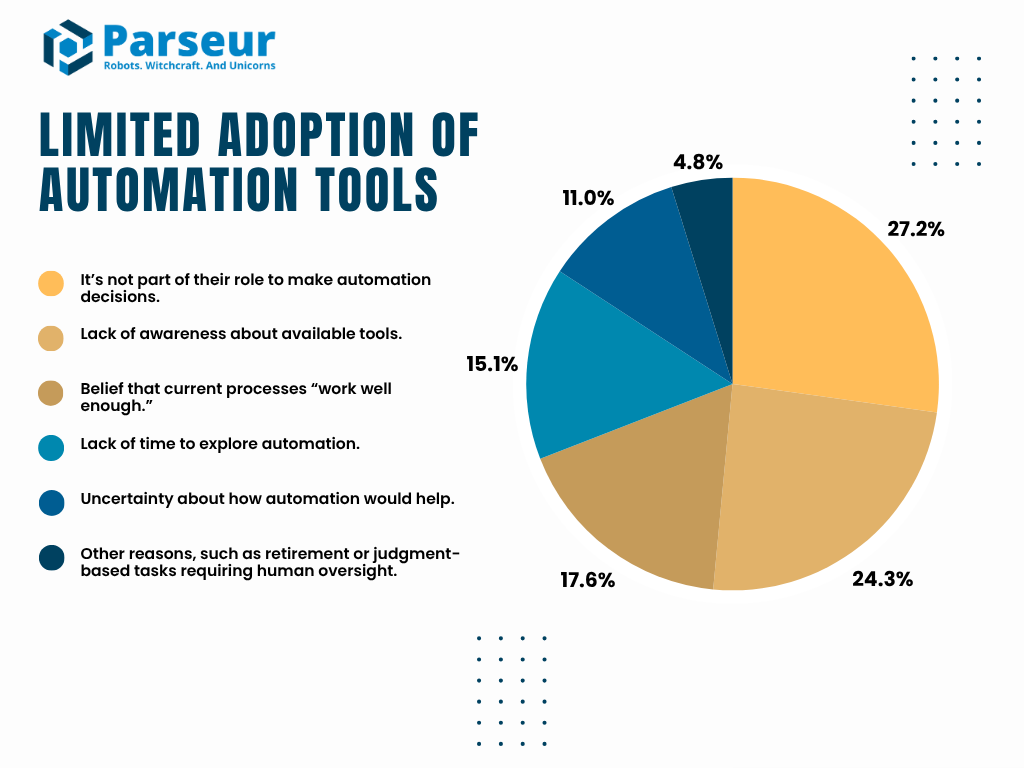
The Proof: Effectiveness And Trust In Automation
While 67.2% of respondents express strong trust in AI-powered tools for accuracy and security, a notable 32.8% still harbor reservations. Our survey uncovered three primary concerns among those hesitant to embrace automation: accuracy, data security, and complexity. Parseur proactively addresses each of these barriers to facilitate smooth, confident adoption.
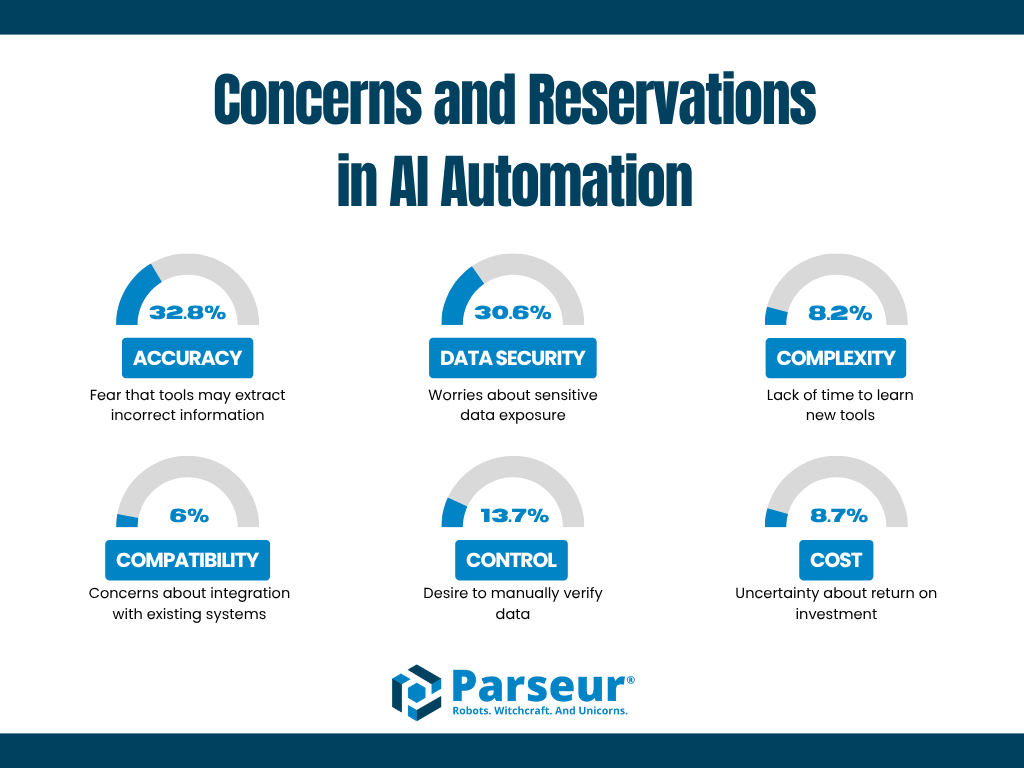
To further build confidence among the cautious 32.8%, Parseur encourages organizations to take advantage of demonstrations, comprehensive tutorials, and responsive support resources. This hands-on approach allows potential users to directly experience Parseur’s ease of use, security measures, and accuracy firsthand, turning skepticism into confidence.
By proactively addressing these barriers, Parseur ensures a seamless transition to automation and positions itself as the trusted leader in intelligent document-processing solutions.
The Opportunity: Reclaiming Time For High-Value Work
Manual data entry doesn't just consume valuable hours; it diverts skilled professionals from tasks that truly drive business growth and customer satisfaction. Our survey respondents highlighted their preferred ways to use time reclaimed through automation:
- Strategic Planning (27.2%): Professionals prioritize strategic thinking and long-term business planning, critical activities often sidelined by routine data tasks.
- Customer Experience Enhancement (22.4%): Time saved from automation can significantly improve customer service quality, responsiveness, and overall client relationships.
- Revenue-focused Activities (14.2%): Employees would redirect their efforts toward sales, business development, and other revenue-generating tasks.
- Team Leadership (13.4%) and Creative/Analytical Work (12.2%): More time would allow employees to mentor, innovate, and analyze data strategically, elevating overall organizational performance.
If manual data entry were eliminated, respondents would prefer to spend their time on:
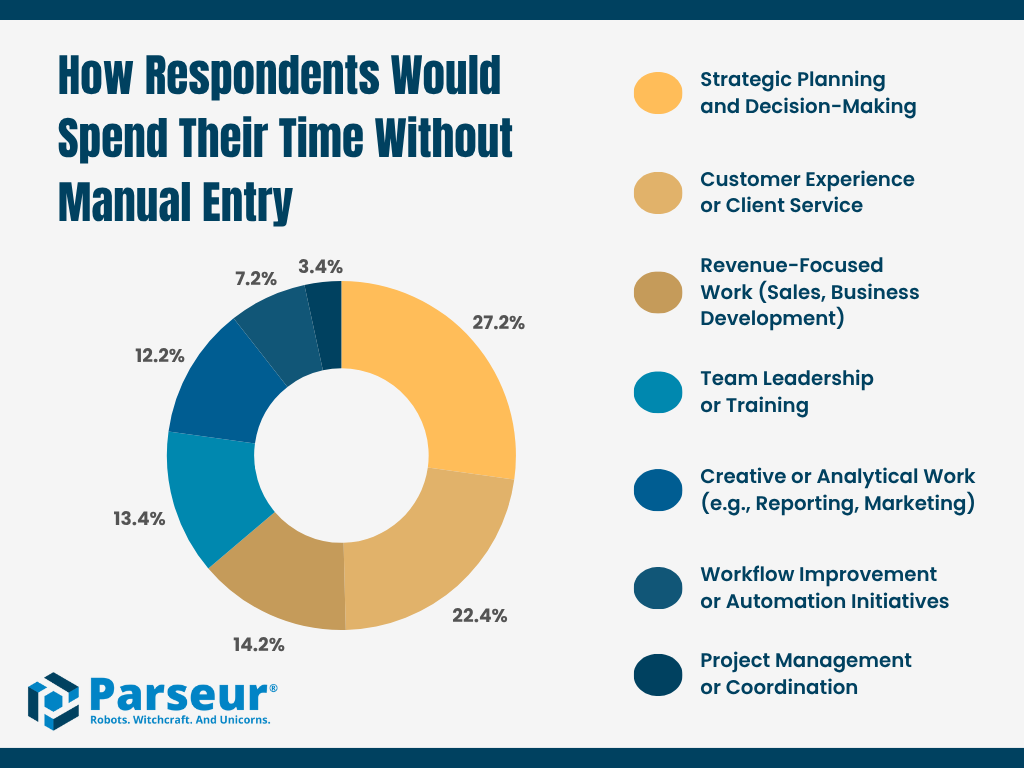
Automation doesn't merely eliminate manual labor; it transforms the very nature of work, empowering employees to focus on impactful, fulfilling, and strategically valuable activities.
Parseur’s intelligent document-processing solution is designed precisely to enable this transformation. By automating tedious data extraction tasks, Parseur frees your team to concentrate on meaningful work that drives revenue, enhances customer satisfaction, and supports innovation.
Explore Parseur’s intuitive platform and discover firsthand how eliminating manual data entry can revolutionize your business operations and empower your teams to achieve more.
Looking Ahead: Automation’s Future Impact
Industry trends indicate manual data entry tasks will likely vanish from competitive industries by 2030. Forward-thinking businesses that adopt automation now will secure substantial strategic and competitive advantages.
This detailed survey analysis highlights the imperative to transition from manual data entry to intelligent automation. Parseur stands ready as your partner in this journey, offering secure, efficient, and user-friendly solutions.
Explore automation possibilities with Parseur, reclaim lost productivity, boost employee satisfaction, and propel your business strategically forward.
Annex: Who’s Affected And Why It Matters?
Manual data entry isn’t confined to a niche set of roles or specific industries; it’s a widespread productivity drain affecting professionals across multiple departments and diverse industries. Our 2025 survey findings demonstrate the universal relevance of this issue.
Departmental insights:
Respondents were drawn from a broad range of roles, with significant representation from:
- Operations (13.6%): These teams frequently handle work orders, purchase orders, and inventory data and endure repetitive manual processes that directly impact operational efficiency.
- Sales (13.4%): Sales professionals spend valuable time processing sales orders and contracts, diverting attention from customer-facing activities and revenue generation.
- IT (12.8%) and Finance (8.4%): Notably, these departments report some of the highest weekly hours devoted to manual data entry tasks. Given their higher pay brackets ($50–$90 per hour), the financial impact on organizations becomes dramatically intensified.
- Customer Support (10.4%): Employees in customer support roles frequently process customer intake forms and service requests manually, slowing down customer service response times and negatively impacting customer satisfaction.
Additionally, a quarter (25.8%) of respondents from other roles, including HR, education, healthcare, and administration, indicate that manual data entry also disrupts their productivity, proving that automation isn't a luxury but a fundamental operational necessity across the board.
Geographic diversity:
The survey also highlighted a broad geographic representation, covering professionals across 37 different states, with significant participation from states such as:
- Florida (10.4%)
- California (8%)
- Texas (7.6%)
- New York (6.2%)
- Pennsylvania (5.4%)
This wide geographic reach underscores the universal nature of the challenges posed by manual data entry, highlighting that regardless of location or industry specifics, businesses nationwide are impacted by similar operational inefficiencies and productivity drains.
Understanding who’s affected and how they’re impacted provides critical insight for organizations looking to adopt effective, scalable automation solutions, solutions capable of addressing not just specific departmental needs but widespread organizational inefficiencies.
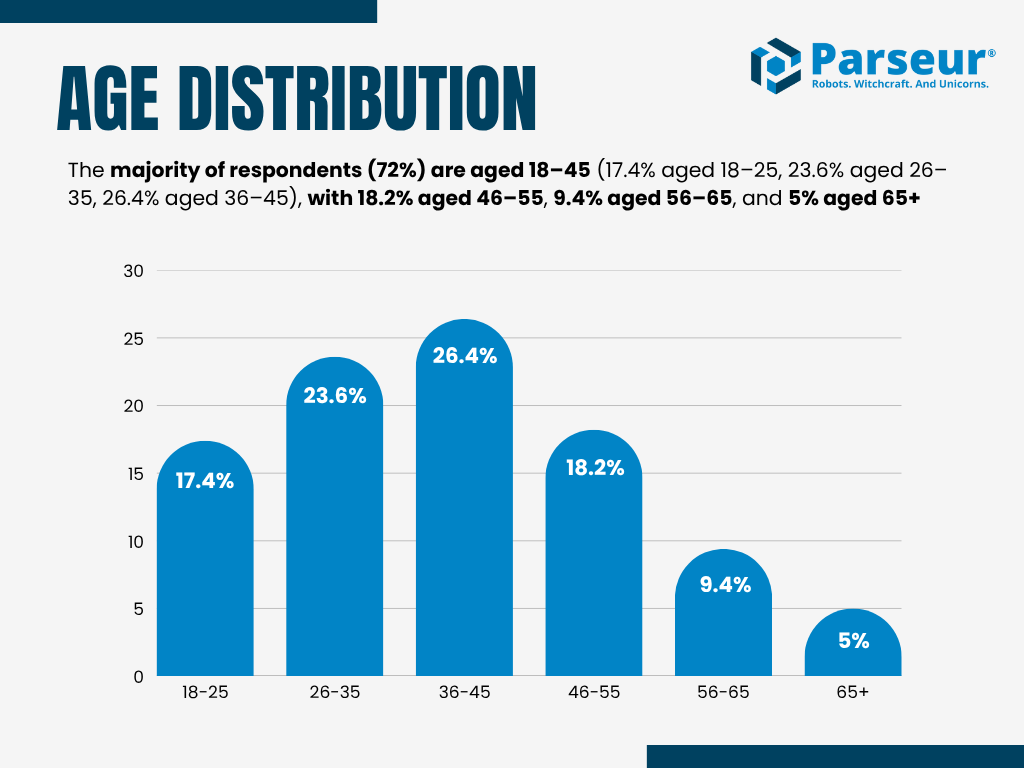
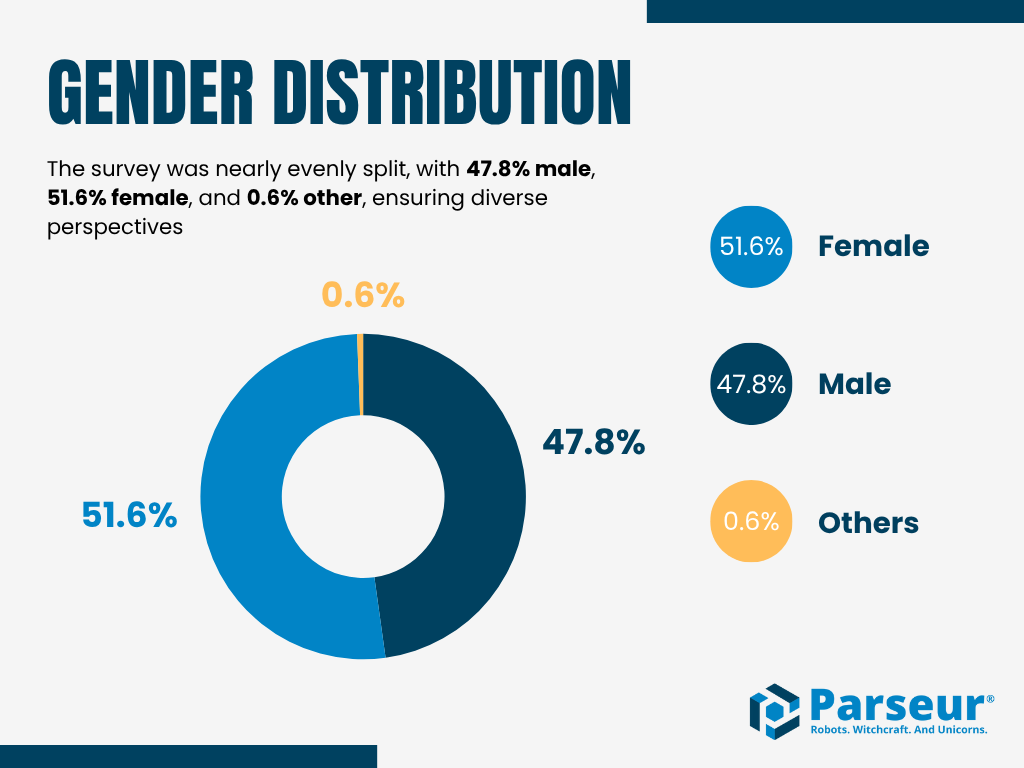
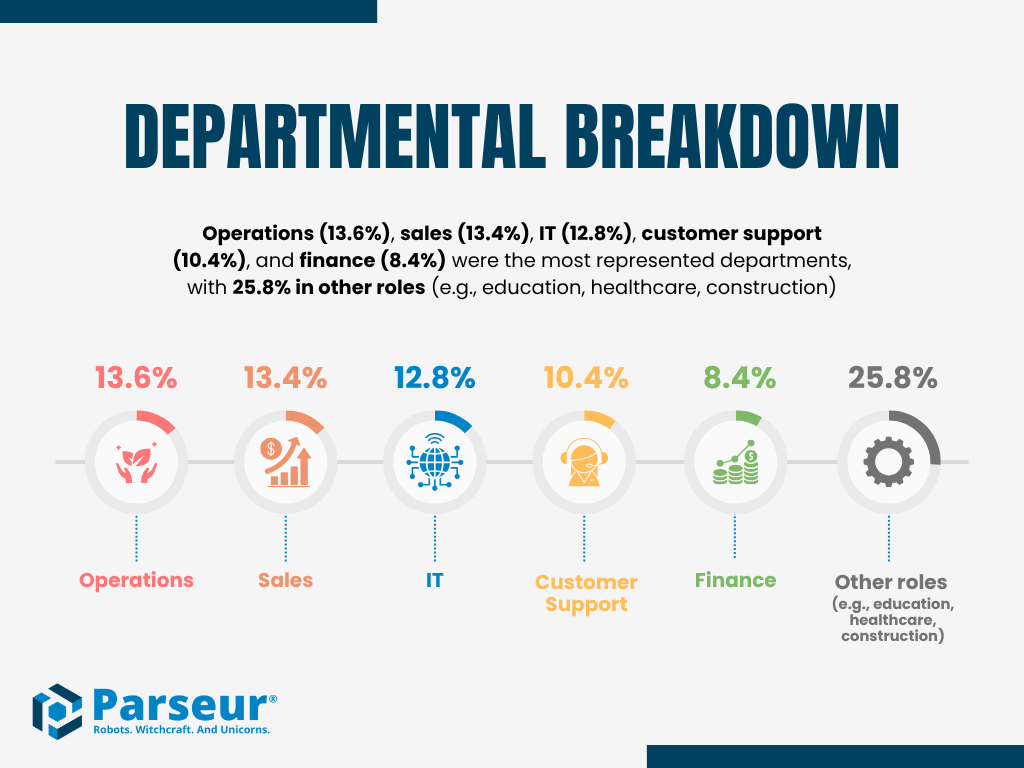


Pay bracket insights
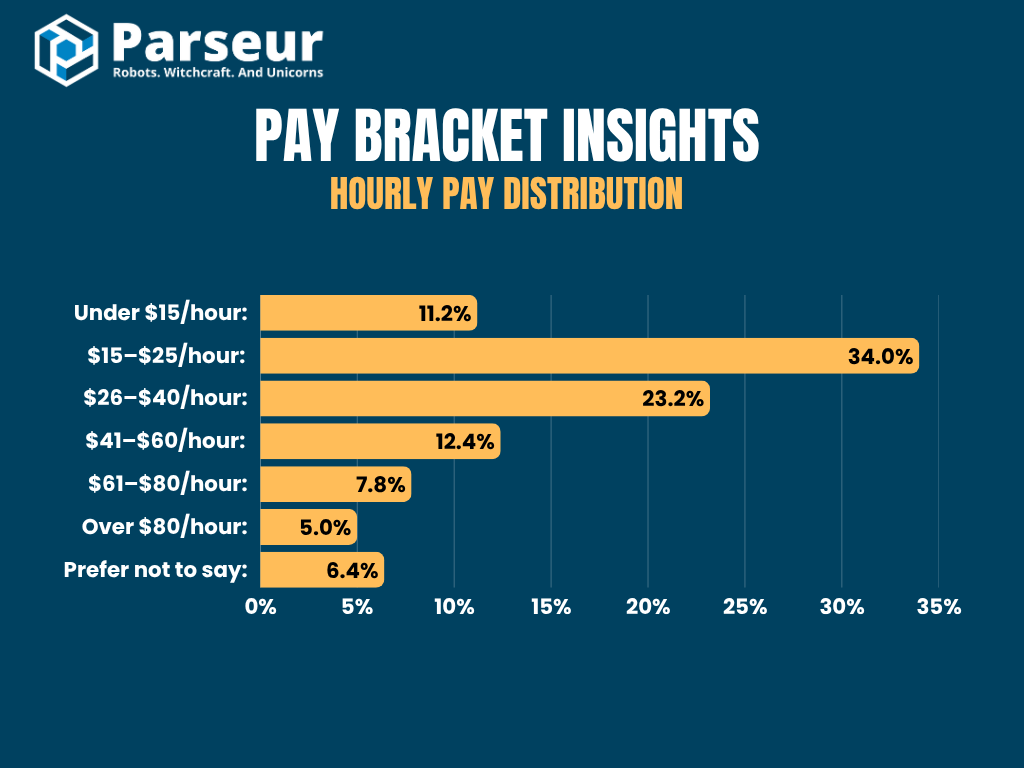
Employees in higher pay brackets ($41–$80/hour or more) are more likely to work in IT and finance and spend more time on data entry (20+ hours), amplifying the cost impact for businesses.
Last updated on




